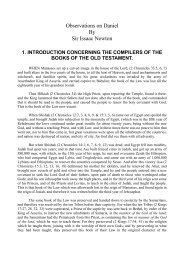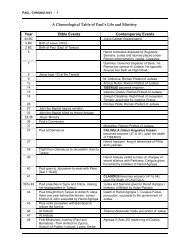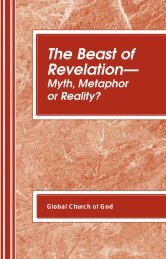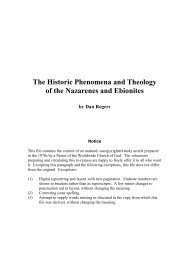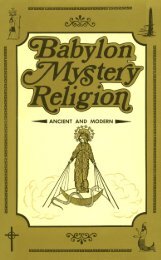THE EARLY CHRISTIAN SABBATH - Friends of the Sabbath Australia
THE EARLY CHRISTIAN SABBATH - Friends of the Sabbath Australia
THE EARLY CHRISTIAN SABBATH - Friends of the Sabbath Australia
Create successful ePaper yourself
Turn your PDF publications into a flip-book with our unique Google optimized e-Paper software.
The Early Christian <strong>Sabbath</strong><br />
<strong>Sabbath</strong> he retained from <strong>the</strong> ancient Scriptures!'-In Migne, Patrologia Latina, volume 90,<br />
column 584.<br />
In <strong>the</strong> meantime, a sect <strong>of</strong> sun worshipers had been making great progress in <strong>the</strong><br />
Roman Empire. A peculiar form <strong>of</strong> <strong>the</strong> cult <strong>of</strong> <strong>the</strong> sun was introduced from Persia by<br />
Roman soldiery who had, in <strong>the</strong> century before Christ, been campaigning in <strong>the</strong> east. This<br />
form <strong>of</strong> worship is called Mithraism, and its deity was Sol Invictus, or <strong>the</strong> unconquerable<br />
sun. According to archaeological evidence, <strong>the</strong> Mithraists used Sunday, <strong>the</strong> first day <strong>of</strong><br />
<strong>the</strong> week, .as <strong>the</strong>ir day for doing special honor to <strong>the</strong> sun. Franz Cumont, <strong>the</strong> great French<br />
authority on Mithraism, in his book, The Mysteries <strong>of</strong> Mithra, page 191, says that <strong>the</strong><br />
Mithraists “held Sunday sacred and celebrated <strong>the</strong> birth <strong>of</strong> <strong>the</strong> Sun on <strong>the</strong> twenty-fifth <strong>of</strong><br />
December.”<br />
However, sun worship in <strong>the</strong> Roman Empire was not by any manner <strong>of</strong> means<br />
dependent for its continuance upon <strong>the</strong> Mithraists. In fact, sun worship has always been a<br />
characteristic <strong>of</strong> hea<strong>the</strong>n religions everywhere and at all times, and Roman religion was<br />
by no means an exception. Again and again <strong>the</strong> Roman emperors showed <strong>the</strong>ir great<br />
interest in sun worship. For instance, Bassianus, who under '<strong>the</strong> name <strong>of</strong> Heliogabalus<br />
(<strong>the</strong> sun god) was emperor <strong>of</strong> <strong>the</strong> Roman Empire (AD 218-222), had been a priest <strong>of</strong> sun<br />
worship in <strong>the</strong> eastern city <strong>of</strong> Emesa before he was placed by <strong>the</strong> soldiery on <strong>the</strong> imperial<br />
throne. The emperor Aurelian (AD 270-275) enriched <strong>the</strong> old, magnificent temple <strong>of</strong> <strong>the</strong><br />
sun in Rome with gifts and embellishments amounting to several millions <strong>of</strong> dollars in<br />
value.<br />
Constantius, <strong>the</strong> fa<strong>the</strong>r <strong>of</strong> Emperor Constantine <strong>the</strong> Great, Saw in sun worship a<br />
type <strong>of</strong> mono<strong>the</strong>ism which pleased him. Through Christian associates, such for instance<br />
as his concubine, <strong>the</strong> mo<strong>the</strong>r <strong>of</strong> Constantine, he was aware <strong>of</strong> Christianity; and it is<br />
probable that he saw similarities in <strong>the</strong> two kinds <strong>of</strong> worship. However that may be, his<br />
son Constantine, who had <strong>the</strong> title <strong>of</strong> emperor from <strong>the</strong> year 306, and was sole emperor<br />
from 323 to 337, When he died, was devoted to <strong>the</strong> worship <strong>of</strong> <strong>the</strong> sun. We read this<br />
description:<br />
“His liberality restored and enriched <strong>the</strong> temples <strong>of</strong> <strong>the</strong> gods; <strong>the</strong> medals which<br />
issued from his imperial mint are impressed with <strong>the</strong> figures and attributes <strong>of</strong> Jupiter and<br />
Apollo, <strong>of</strong> Mars and Hercules; and his filial piety increased <strong>the</strong> council <strong>of</strong> Olympus by<br />
<strong>the</strong> solemn apo<strong>the</strong>osis <strong>of</strong> his fa<strong>the</strong>r Constantius. But <strong>the</strong> devotion <strong>of</strong> Constantine was<br />
more peculiarly directed to <strong>the</strong> genius <strong>of</strong> <strong>the</strong> Sun, <strong>the</strong> Apollo <strong>of</strong> Creek and Roman<br />
mythology; and he was pleased to be represented with <strong>the</strong> symbols <strong>of</strong> <strong>the</strong> God <strong>of</strong> Light<br />
and Poetry. The unerring shafts <strong>of</strong> that idol, <strong>the</strong> brightness <strong>of</strong> his eyes, his laurel wreath,<br />
immortal beauty, and elegant accomplishments seem to point him out as <strong>the</strong>-patron <strong>of</strong> a<br />
young hero. The altars <strong>of</strong> Apollo were crowned with <strong>the</strong> votive <strong>of</strong>ferings <strong>of</strong> Constantine;<br />
and <strong>the</strong> credulous multitude were taught to believe that <strong>the</strong> emperor was permitted to<br />
behold with mortal eyes <strong>the</strong> visible majesty <strong>of</strong> <strong>the</strong>ir Solar deity. And that, ei<strong>the</strong>r waking<br />
or in a vision, he was blessed with <strong>the</strong> auspicious omens <strong>of</strong> a long and victorious reign.<br />
The Sun was universally celebrated as <strong>the</strong> invincible guide and protector <strong>of</strong> Constantine.”<br />
- Edward Gibbon, The History <strong>of</strong> <strong>the</strong> Decline and Fall <strong>of</strong> <strong>the</strong> Roman Empire, chapter 20,<br />
paragraph 3.<br />
John C. L. Gieseler, <strong>the</strong> careful German scholar and church historian, makes this<br />
comment concerning Constantine's religious expectations:<br />
“With regard to <strong>the</strong> history <strong>of</strong> Constantine's religious development, till <strong>the</strong> time<br />
28



